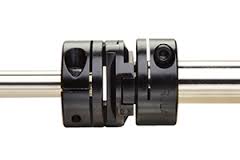Edited by Mike Santora
 Why misalignment is a concern: Because not properly accounting for it can lead to premature coupling or system component failure. It also introduces RPM limitations, vibrations and noise, and potential for damage or injury. Most systems are going to have some type of misalignment.
Why misalignment is a concern: Because not properly accounting for it can lead to premature coupling or system component failure. It also introduces RPM limitations, vibrations and noise, and potential for damage or injury. Most systems are going to have some type of misalignment.
Some of the common causes of misalignment are parts from different manufacturers, (i.e. different couplings, different motors, different lead screws). Inaccuracies in system assembly introduce misalignment, system motor movement during operation and system component wear as well. So there are many, factors that can cause misalignment. You have to make sure that you consider all of them to be sure that you pick the coupling that has the right amount and the right type of misalignment compensation that your looking for.
The types of misalignment are as follows: Angular misalignment, if you’ve got an application where relatively speaking you have a large degree of angular misalignment, a beam coupling might be a good choice. Next is parallel misalignment, where shafts are offset. If you’ve got a large amount of parallel misalignment consider an oldham coupling.
Complex misalignment, this is a combination of angular and parallel. Identifying the amount of misalignment in that complex misalignment application, again, it can lead you to choose the right coupling that’s going to have the right amount of angular and parallel misalignment compensation capabilities to accommodate that complex misalignment that you need to address.
Axial misalignment: With axial misalignment, shafts are moving apart or in towards each other, and is typically caused by thermal expansion of motor shafts. Motors heat up during use and the motor output shafts elongate due to thermal increase. Choosing the right coupling that has axial misalignment to accommodate thermal expansion, of your motor shaft is important. Most of the flexible couplings do accommodate some axial misalignment but rigid couplings do not accommodate axial misalignment. If you have a high-speed motor, and the higher speed motors tend to have more axial elongation of the shaft than the lower speed motors, it’s something to watch out for especially if you decide you want to use a rigid coupling. You want to be sure that you have minimal thermal expansion of your motor shaft.
Ways to evaluate shaft misalignment. Dial indicators are generally good enough for use with servo couplings but are time-consuming. Laser alignment systems, have the highest level of accuracy and can be quicker than a dial indicator system but at significantly higher cost. If you’re using a beam coupling or oldham couplings, typically your good scale is fine. If you’re using bellows couplings, disc couplings, rigid couplings, if you’re using them occasionally, dial indicators are probably the most practical way to ensure that your shafts are aligned. If you’re in volume and you’re building many machines and installing large numbers of rigid couplings, bellow couplings, disc couplings, it’s probably a good idea to invest in a laser alignment system at the point to ensure you’ve got your shafts aligned properly.
Addressing misalignment. Best addressed during system design and testing, be sure that mounts are secure and designed from sturdy material. If there is significant system misalignment, a rigid coupling can be used to align shafts in some cases. The second bullet point, be sure that mounts are secure and designed from sturdy material, the most common problem we see from this is in encoders. Many encoders are mounted on flimsy bench metal brackets which move. While the machine is running, they vibrate. They’re not robust enough so this is an example of sturdy material used for mounts.
Ruland
www.ruland.com
Leave a Reply